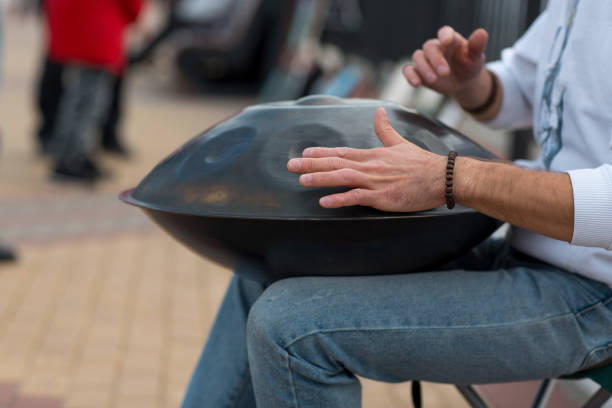Have you ever heard the sound of a handpan?
In moments, it can transport you to a peaceful place. Over the past two decades, this unique instrument has captured the hearts of musicians and music lovers worldwide.
The handpan is not an ordinary instrument. It produces a soothing, melodic sound that feels almost magical. In fact, its popularity has skyrocketed. The Australian percussion instrument market is projected to grow at an annual rate of 1.4% (CAGR 2025-2028) of which the handpan is one of them.
But where did this fascinating instrument come from? How did it become so beloved? In this blog, we’ll discuss the handpan instrument's origin and explore its history, evolution, and why it inspires musicians of all levels.
Let’s uncover the story behind the music, starting with a brief introduction to the instrument itself.
What is a Handpan?
A handpan is a unique and beautiful musical instrument. It is shaped like a flying saucer and made of steel. People play it with their hands, creating soft and melodic sounds.
Handpans are known for their calming and meditative tones.
Basic Construction
A handpan is made from two convex steel sheets, which are carefully shaped and joined together to form a hollow, dome-like structure.
-
The top side has a central note called the ‘ding.’
-
Around the ding are other notes arranged in a circular pattern.
-
The bottom side often has a hole to let the sound resonate beautifully.
Key Features of a Handpan
-
Portable Size: Handpans are lightweight and easy to carry.
-
Rich Sound: They produce deep and resonant tones.
-
Simple to Play: Even beginners can create beautiful music.
-
Customised Scales: Each handpan has a unique scale, such as D Kurd or F Pygmy.
-
Durability: Made of high-quality steel, handpans are long-lasting.
You can also read the What Makes a Great Handpan article.
How is a Handpan Different from Other Instruments?
Handpans are often compared to steel drums and tongue drums, but they are distinct:
-
Steel Drums: These are from Trinidad and Tobago and are played with sticks. Steel drums have a brighter sound and are used in Caribbean music.
-
Tongue Drums: Made by cutting steel to create tongues, tongue drums produce a different tone. They are simpler and usually smaller.
Handpans, however, stand out for their ability to combine rhythm and melody. Their sound feels both modern and ancient, making them a favourite for musicians of all levels.
Whether you are a beginner or a professional, a handpan is an instrument that anyone can enjoy playing. It’s perfect for relaxing, creating music, or even meditating. But where did this instrument come from? Let’s trace the handpan’s origin story.
Tracing the Handpan Instrument Origin
The handpan instrument's origin can be traced back to the influence of the Trinidad steel drum. Steel drums emerged from the Caribbean, gaining popularity for their rich, melodic sound. Their charm soon spread to Europe, inspiring a new wave of musical exploration.
Swiss percussionist Reto Weber was among those captivated by the steel drum. He dreamt of creating a similar instrument that could be played by hand rather than with sticks. This idea sparked the innovation that led to the birth of the handpan.
The journey truly began when Felix Rohner and Sabina Schärer, founders of PANArt in Switzerland, took on the challenge. In 2000, they invented the Hang drum, combining their expertise in steel pan construction with inspiration from ancient percussion instruments.
They also drew inspiration from ancient percussion instruments, such as the Ghatam from India and the Udu from Africa. These clay instruments produce earthy and resonant sounds. The creators wanted to combine these timeless tones with a modern design. Let’s look at how they developed it next.
Development of the Hang
Rohner and Schärer’s work with steel alloys and their love for percussive instruments led to a groundbreaking innovation. They used a special process to treat steel, enhancing its resonance and durability. The result was the first Hang drum, an instrument with a UFO-like shape and an enchanting sound.
In 2001, the Hang was officially introduced at the Frankfurt Musikmesse. It quickly gained attention for its unique design and meditative tones. PANArt took an exclusive approach to its production and distribution, carefully handcrafting each Hang and selling directly to individuals.
Next, let’s look at how the handpan evolved through its challenges.
The Evolution of the Handpan
As the Hang gained popularity, the demand for similar instruments grew. However, PANArt maintained a limited production, leading to a wider market for handpan instruments. Legal restrictions around the Hang’s name prompted the adoption of the term "handpan" to describe this new class of instruments.
Because of this, many musicians had to wait months or even years to get their hands on one. This made the Hang drum rare and highly sought after.
Exclusive Sales Process
You couldn’t buy a Hang drum at a store in the early years. Musicians had to write a letter to PANArt explaining why they wanted one. They were invited to Switzerland to pick up their request in person if it was accepted.
This made the instrument even more challenging to get. Many people loved owning a Hang drum but couldn’t meet these conditions.
Over time, new builders entered the market, creating diverse designs and improving accessibility. These modern handpans feature a variety of scales, tunings, and materials, catering to musicians of all levels—from beginners to professionals.
Today, the handpan is a global phenomenon. It has evolved far beyond its origins, yet it continues to carry the spirit of its creators and the rich traditions that inspired it.
This remarkable journey from the Caribbean steel drum to the Swiss innovation of the Hang and handpan demonstrates how music transcends borders and evolves with time.
Today, there are many handpan makers worldwide, including in Australia and New Zealand. This competition has improved availability and variety, but it has also made it harder for musicians to choose the right handpan.
NovaPans Australia helps solve this problem. We offer a range of high-quality handpans for beginners, intermediates, and professionals. With NovaPans Australia, the magic of handpans is now within reach for everyone.
Now, let’s look at why the handpan captured the listener’s heart and soul.
Why the Handpan Captures Hearts
The handpan is more than just a musical instrument. Its soothing and unique sound creates an emotional connection for anyone who hears it. Whether you’re playing it yourself or listening to someone else, the handpan can calm the mind and lift the spirit.
A Sound That Heals
The handpan’s sound is gentle and meditative. It has a natural resonance that feels calming. Many people describe it as a “healing” instrument.
Musicians and therapists use handpans to help with relaxation. The soft, melodic tones are perfect for yoga, meditation, and even stress relief. They create a peaceful space where you can unwind.
Perfect for Mindfulness and Therapy
The handpan is becoming a favourite in therapy sessions. Music therapists use it to help people feel more connected and centred. Its sound enables you to focus and find peace.
In mindfulness practice, the handpan provides a steady, flowing sound that is easy to follow. This makes it an excellent tool for guided meditation or personal relaxation.
Loved Around the World
Musicians use the handpan in many styles, including world music, ambient music, and even film scores. It fits beautifully into any setting, from a quiet beach in Australia to a concert hall in New Zealand.
What Others Say
Handpan players often talk about how it changes their lives. Beginners love how simple it is to start playing. Professionals enjoy its versatility. Here’s what some have said:
-
The song of this handpan is so peaceful.
-
It has a beautiful sound and is easy to play.
-
This time last year, I had lost my granny unexpectedly, and my job position was taken away from me after almost 10 years dedicated to the company I work for. This had put me in a very difficult time in my life, but learning the handpan was a huge help in my grieving process. The notes and harmonies produced have helped me in ways to enjoy and love life again.
Whether you’re new to music or a seasoned player, the handpan offers something. Its sound speaks to everyone. It’s an instrument you’ll love from the first note.
NovaPans Australia: A Haven for Handpan Enthusiasts
At NovaPans Australia, the love for handpans runs deep. We are passionate about bringing this unique instrument to musicians and enthusiasts across Australia and New Zealand.
We offer a stunning collection of high-quality handpans. Whether you're a beginner exploring the instrument for the first time, an intermediate player looking to refine your skills, or a professional musician seeking the perfect sound, we have a handpan for you.
At NovaPans Australia, we share the handpan drum history and inspire others to explore its unique sound. We actively promote awareness about this fascinating instrument and its cultural significance.
The team at NovaPans Australia also plays a big role in building the Australian handpan community. With us, you’re not just buying an instrument but joining a community.
Conclusion: A Modern Instrument with Ancient Soul
The handpan is more than just an instrument. It’s a blend of ancient traditions and modern innovation. Its soothing sounds can touch the soul and bring people together.
From its origins in Switzerland to its global popularity today, the handpan has come a long way. Whether you’re a musician, teacher, or music lover, the handpan offers endless possibilities.
At NovaPans Australia, you can experience the magic of this instrument. With our wide range of handpans and commitment to the community, we make it easy to start.
So why wait? Discover the magic of handpans with NovaPans Australia. Start your musical journey today!

